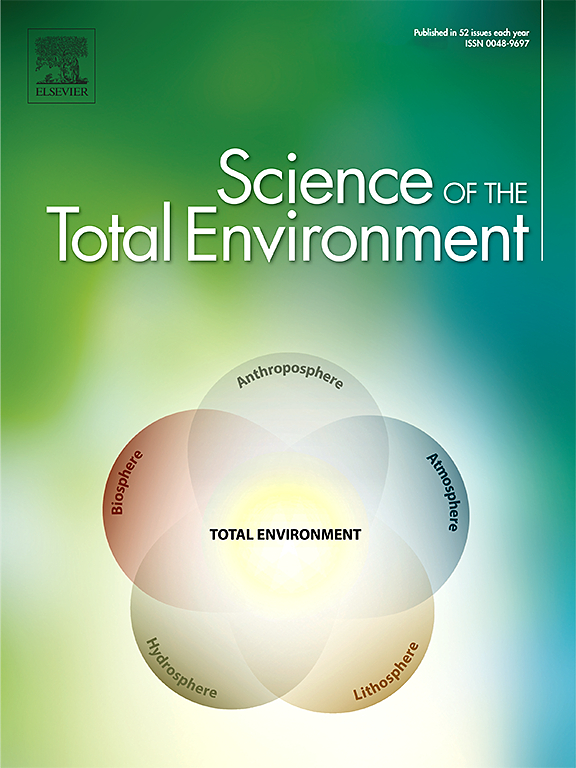Regulatory mechanism of microplastics on arsenic bioavailability in a subtropical estuary, China
IF 8.2
1区 环境科学与生态学
Q1 ENVIRONMENTAL SCIENCES
引用次数: 0
Abstract
The increasingly prominent microplastics (MPs) pollution may affect the dynamics of arsenic (As) in estuarine sediments, but the effect of MPs on the bioavailable arsenic (bio-As) and its regulatory mechanism are still unclear. In this study Min River estuary, a typical subtropical estuary, was selected, and DGT technology was used to explore the pattern of change, composition characteristics and regulatory mechanism of bio-As in sediment under the influence of MPs (type: polylactic acid (PLA) and polyethylene terephthalate (PET); dose: 1 % and 5 %) through incubation experiments. The results showed that (1) the low-dose PET significantly increased the concentration of bio-As, (2) during the incubation experiment, the effect of MPs on the composition of the bio-As was phased. In general, PLA and 5 % PET inhibited the oxidation of As(III), respectively, while 1 % PET did the opposite, (3) the low-dose PET significantly increased the diversity of microbial community, (4) Bacteroidetes, Firmicutes, Proteobacteria, Desulfobacterota, and Chloroflexi were the most dominant microbial groups. (5) PET decreased the abundances of Bacteroides, Desulphurobacteria and Chlorocurvula, but increased the abundances of Proteobacteria. PLA decreased the abundance of Firmicutes and Chlorocurvula, and increased the abundance of desulphurobacteria and Proteobacteria, and (6) Marinobacter and Pseudomonas would directly promote the redox reaction of As. The bacteria Bacillus, Alkaliphilus, Haloplasma, Caminicella, Clostridiisalibacter, Desulfopila, and Desulfuromonas were able to influence the change of As by changing environmental factors.

亚热带河口微塑料对砷生物利用度的调控机制
日益突出的微塑料污染可能会影响河口沉积物中砷的动态变化,但微塑料对生物可利用性砷的影响及其调控机制尚不清楚。本研究以典型的亚热带河口闽江口为研究对象,采用DGT技术探讨了MPs(类型:聚乳酸(PLA)和聚对苯二甲酸乙二醇酯(PET))影响下沉积物中生物砷的变化规律、组成特征及调控机制;剂量:1%和5%)孵育实验。结果表明:(1)低剂量PET显著提高了生物as的浓度;(2)在孵育实验期间,MPs对生物as组成的影响是阶段性的。总体而言,PLA和5% PET分别抑制As(III)的氧化,而1% PET则相反,(3)低剂量PET显著增加了微生物群落的多样性,(4)Bacteroidetes, Firmicutes, Proteobacteria, desulfobacteria和Chloroflexi是最优势的微生物群。(5) PET降低了拟杆菌(Bacteroides)、脱硫菌(Desulphurobacteria)和绿弧菌(Chlorocurvula)的丰度,提高了变形菌门(Proteobacteria)的丰度。PLA降低了厚壁菌门和绿门菌门的丰度,增加了脱硫菌门和变形菌门的丰度,(6)海洋杆菌门和假单胞菌门会直接促进As的氧化还原反应。细菌Bacillus、Alkaliphilus、Haloplasma、Caminicella、clostrididiisalibacter、Desulfopila和Desulfuromonas可以通过改变环境因素影响As的变化。
本文章由计算机程序翻译,如有差异,请以英文原文为准。
求助全文
约1分钟内获得全文
求助全文
来源期刊

Science of the Total Environment
环境科学-环境科学
CiteScore
17.60
自引率
10.20%
发文量
8726
审稿时长
2.4 months
期刊介绍:
The Science of the Total Environment is an international journal dedicated to scientific research on the environment and its interaction with humanity. It covers a wide range of disciplines and seeks to publish innovative, hypothesis-driven, and impactful research that explores the entire environment, including the atmosphere, lithosphere, hydrosphere, biosphere, and anthroposphere.
The journal's updated Aims & Scope emphasizes the importance of interdisciplinary environmental research with broad impact. Priority is given to studies that advance fundamental understanding and explore the interconnectedness of multiple environmental spheres. Field studies are preferred, while laboratory experiments must demonstrate significant methodological advancements or mechanistic insights with direct relevance to the environment.
 求助内容:
求助内容: 应助结果提醒方式:
应助结果提醒方式:


